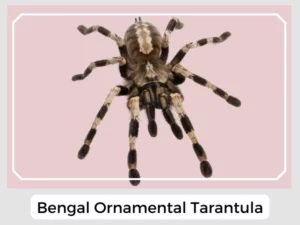Meet the Bengal ornamental tarantula! This unique spider calls India its home. Because it’s hard to spot and lives in just a tiny area, it’s considered “Endangered.” Stick around to uncover amazing facts about this special tarantula!
Their eggs are protected by placing them in a web sac.
Juvenile Bengal ornamentals appear as miniature adults.
They do not construct elaborate webbing.
Yes, Bengal Ornamental tarantulas have venom. They use it to catch their favorite snacks, like bugs. Their venom is quite potent, and while it isn’t too aggressive, a bite from these tarantulas could lead to complications and even hospitalization in severe cases.
They sure can! Bengal Ornamental tarantulas are generally calm, but if they feel threatened, they might bite. Still, they mostly keep to themselves and their webs.
The Bengal ornamental tarantula plays a critical role in maintaining the health of its ecosystem. As a predator, it helps regulate the populations of insects, contributing to the balance of its forest home. Their behavior is largely secretive, and they prefer the solitude of their forest habitat.
Natural Predator: Birds of prey, larger mammals, and other predatory spiders are among their natural threats. The tarantula’s cryptic lifestyle helps protect it from these predators.
Prey-Predator Dynamics: In the food web, Bengal ornamental tarantulas are apex invertebrate predators, controlling the insect population which in turn influences the vegetation and overall health of the forest.
Relationship with Humans: Human interaction with Bengal ornamental tarantulas is minimal, primarily due to their secluded nature. However, due to their beauty, they are sometimes captured for the pet trade, which, along with habitat loss, has contributed to their endangered status.
| Other names | Wonderful Parachute Spider |
| Lifespan | Males: 2-3 years, Females: 11-12 years |
| Distribution | The Chhota Nagpur Plateau in India |
| Habitat | Deciduous forests |
| Diet | Butterworms, cockroaches, crickets, houseflies, locusts, mealworms, and super worms |

In conclusion, the Bengal ornamental tarantula is a splendid yet vulnerable species whose existence is vital to its native ecosystem.
Meet the Bengal ornamental tarantula! This unique spider calls India its home. Because it’s hard to spot and lives in just a tiny area, it’s considered “Endangered.” Stick around to uncover amazing facts about this special tarantula!
Their eggs are protected by placing them in a web sac.
Juvenile Bengal ornamentals appear as miniature adults.
They do not construct elaborate webbing.
Yes, Bengal Ornamental tarantulas have venom. They use it to catch their favorite snacks, like bugs. Their venom is quite potent, and while it isn’t too aggressive, a bite from these tarantulas could lead to complications and even hospitalization in severe cases.
They sure can! Bengal Ornamental tarantulas are generally calm, but if they feel threatened, they might bite. Still, they mostly keep to themselves and their webs.
The Bengal ornamental tarantula plays a critical role in maintaining the health of its ecosystem. As a predator, it helps regulate the populations of insects, contributing to the balance of its forest home. Their behavior is largely secretive, and they prefer the solitude of their forest habitat.
Natural Predator: Birds of prey, larger mammals, and other predatory spiders are among their natural threats. The tarantula’s cryptic lifestyle helps protect it from these predators.
Prey-Predator Dynamics: In the food web, Bengal ornamental tarantulas are apex invertebrate predators, controlling the insect population which in turn influences the vegetation and overall health of the forest.
Relationship with Humans: Human interaction with Bengal ornamental tarantulas is minimal, primarily due to their secluded nature. However, due to their beauty, they are sometimes captured for the pet trade, which, along with habitat loss, has contributed to their endangered status.
| Other names | Wonderful Parachute Spider |
| Lifespan | Males: 2-3 years, Females: 11-12 years |
| Distribution | The Chhota Nagpur Plateau in India |
| Habitat | Deciduous forests |
| Diet | Butterworms, cockroaches, crickets, houseflies, locusts, mealworms, and super worms |

In conclusion, the Bengal ornamental tarantula is a splendid yet vulnerable species whose existence is vital to its native ecosystem.